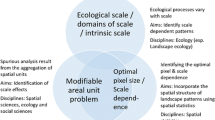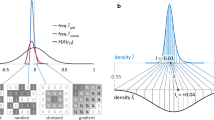Abstract
Landscape ecologists often deal with aggregated data and multiscaled spatial phenomena. Recognizing the sensitivity of the results of spatial analyses to the definition of units for which data are collected is critical to characterizing landscapes with minimal bias and avoidance of spurious relationships. We introduce and examine the effect of data aggregation on analysis of landscape structure as exemplified through what has become known, in the statistical and geographical literature, as theModifiable Areal Unit Problem (MAUP). The MAUP applies to two separate, but interrelated, problems with spatial data analysis. The first is the “scale problem”, where the same set of areal data is aggregated into several sets of larger areal units, with each combination leading to different data values and inferences. The second aspect of the MAUP is the “zoning problem”, where a given set of areal units is recombined into zones that are of the same size but located differently, again resulting in variation in data values and, consequently, different conclusions. We conduct a series of spatial autocorrelation analyses based on NDVI (Normalized Difference Vegetation Index) to demonstrate how the MAUP may affect the results of landscape analysis. We conclude with a discussion of the broader-scale implications for the MAUP in landscape ecology and suggest approaches for dealing with this issue.
Similar content being viewed by others
References
Allen, T.F.H. and Starr, T.B. 1982. Hierarchy. University of Chicago Press, Chicago.
Amrhein, C. and Flowerdew, R. 1989. The effect of data aggregation on a Poisson regression model of Canadian migration.In: Accuracy of Spatial Databases. pp. 229–238. Edited by M.F. Goodchild and S. Gopal, Taylor and Francis, London.
Box, E., Holben, B.N. and Kalb, V. 1989. Accuracy of the AVHRR vegetation index as a predictor of biomass, primary productivity and net CO2 flux. Vegetation 80: 71–89.
Burke, I.C., Kittel, T.G.F., Lauenroth, W.K., Snook, P., Yonker, C.M. and Parton, W.J. 1991. Regional analysis of the Great Plains. BioScience 25: 685–692.
Cliff, A.D. and Ord, J.K. 1973. Spatial Autocorrelation. Pion, London.
Cressie, N.A.C. 1993. Statistics for Spatial Data. J. Wiley, New York.
Cullinan, V.I. and Thomas, J.M. 1992. A comparison of quantitative methods for examining landscape pattern and scale. Landscape Ecology 7: 211.
DeAngelis, D.L. and Gross, L.J. (eds.) 1992. Individual-Based Models and Approaches in Ecology: Populations, Communities and Ecosystems. Chapman & Hall, New York.
DeAngelis, D.L. and Waterhouse, J.C. 1987. Equilibrium and nonequilibrium concepts in ecological models. Ecological Monographs 57: 1–21.
Elliott-Fisk, D.L. The Boreal Forest. In North American Terrestrial Vegetation, pp. 33–62. Edited by M.G. Barbour and W.D. Billings. Cambridge University Press, Cambridge.
Errington, J.C. 1973. The effect of regular and random distributions on the analysis of pattern. Journal of Ecology 61: 99–105.
Forman, R.T.T. and Godron, M. 1986. Landscape Ecology. John Riley & Sons, New York.
Fotheringham, A.S., 1989. Scale-independent spatial analysis.In: Accuracy of Spatial Databases, pp. 221–228. Edited by M.F. Goodchild and S. Gopal. Taylor and Francis, London.
Fotheringham, A.S., and Rogerson, P.A. 1993. GIS and spatial analytical problems. International Journal of Geographic Information Systems 7: 3–19.
Fotheringham, A.S., and Wong, D.W.S. 1991. the modifiable areal unit problem in statistical analysis. Environment and Planning A 23: 1025–1044.
Gardner, R.H., Cale, W.G. and O'Neill, R.V. 1982. Robust analysis of aggregation error. Ecology 63: 1771–1779.
Greig-Smith, P. 1952. The use of random and contiguous quadrats in the study of the structure of plant communities. Annals of Botany, New Series 16: 293–316.
Greig-Smith, P. 1957. Quantitative Plant Ecology. Academic Press, New York.
Greig-Smith, P. 1979. Pattern in vegetation. Journal of Ecology. 67: 755–779.
Greig-Smith, P. 1983. Quantitative Plant Ecology, 3rd ed. University of California Press, Berkeley.
Hall, F.G., Strebel, D.E. and Sellers, P.J. 1988. Linking knowledge among spatial and temporal scales: Vegetation, atmosphere, climate and remote sensing. Landscape Ecology 2: 3–22.
Jelinski, D.E., Goodchild, M. and Steyaert, L. 1994. Multiple roles for GIS in global change research: towards a research agenda.In: Environmental Information Management and Analysis: Ecosystem to Global Scales. pp. 41–56. Edited by W.K. Michener, J.W. Brunt and S.G. Stafford, Taylor & Francis, London.
Johnson, D.D. and Howarth, P.J. 1987. The effects of spatial resolution on land cover/land use theme extraction from airborne digital data. Canadian Journal of Remote Sensing 13: 68–74.
Kershaw, K.A. 1957. The use of cover and frequency in the detection of pattern in plant communities. Ecology 38: 291–299.
Kershaw, K.A. 1964. Quantitative and Dynamic Ecology. Edward Arnold, London.
Legendre, P. and Fortin, M.-J.F. 1989. Spatial pattern and ecological analysis. Vegetatio 80: 107–138.
Levin, S.A. 1992. The problem of pattern and scale in ecology. Ecology 73: 1943–1967.
Levin, S.A. 1993. Concepts of scale at the local level.In: Scaling Physiological Processes: Leaf to Globe. pp. 7–19. Edited by J.R. Ebleringer and C.B. Field. Academic Press, San Diego, California.
Loveland, T.R., Merchant, J.W., Ohlen, D.O. and Brown, J.F. 1991. Development of a landcover characteristics database for the conterminous U.S. Photogrammetric Engineering and Remote Sensing 57: 1453–1463.
Meentemeyer, V. 1989. Geographical perspectives of space, time, and scale. Landscape Ecology 3: 163–173.
Milne, B.T. 1988. Measuring the fractal geometry of landscapes. Applied Mathematics and Computing 27: 67–79.
Nellis, M.D. and Briggs, J.M. 1989. The effect of spatial scale on Konza landscape classification using textural analysis. Landscape Ecology 2: 93–100.
O'Neill, R.V., DeAngelis, D.L., Waide, J.B. and Allen, T.F.H. 1986. A hierarchical concept of ecosystems. Princeton University Press, Princeton, New Jersey.
Openshaw, S. 1977. Optimal zoning systems for spatial interaction models. Environment and Planning A: 169–184.
Openshaw, S. 1984. The modifiable areal unit problem. CATMOG 38. GeoBooks, Norwich, England.
Openshaw, S. and Taylor, P. 1979. A million or so correlation coefficients: three experiments on the modifiable areal unit problem.In: Statistical Applications in the Spatial Sciences. pp. 127–144. Edited by N. Wrigley. Pion, London.
Openshaw, S. and Taylor, P.J. 1981. The modifiable areal unit problem.In: Quantitative Geography: A British View. pp. 60–69. Edited by N. Wrigley and R. Bennett. Routledge and Kegan Paul, London.
Openshaw, S., Charlton, M., Wymer, C. and Craft, A. 1987. Mark I geographical analysis machine for the automated analysis of point data sets. International Journal of Geographic Information Systems 1: 35–51.
Openshaw, S., Charlton, M. and Craft, A. 1988. Searching for Leukemia clusters using a geographical analysis machine. Papers of the Regional Science Association 64: 95–106.
Gehlke, C.E. and Biehl, K. 1934. Certain effects of grouping upon the size of the correlation coefficient in census tract material. Journal of the American Statistical Association Supplement 29: 169–170.
Pacala, S.W. and Silander Jr., J.A. 1985. Neighborhood models of plant population dynamics: I. Single-species models of annuals. American Naturalist 125: 385–411.
Putnam, S.H. and Chung, S.-H. 1989. Effects of spatial system design on spatial interaction models. 1: The spatial system definition problem. Environment of Planning A 21: 27–46.
Rastetter, E.B., King, A.W., Cosby, B.J., Hornberger, G.M., O'Neill, R.V. and Hobbie, J.E. 1992. Aggregating fine-scale ecological knowledge to model coarser-scale attributes of ecosystems. Ecological Applications 2: 55–70.
Robinson, A.H. 1950. Ecological correlation and the behaviour of individuals. American Sociological Review 15: 351–357.
Rosswall, T., Woodmansee, R.G. and Risser, P.G., editors. 1988. Scales and Global Change. John Wiley & Sons, New York.
Roughgarden, J., Running, S.W. and Matson, P.A. 1991. What does remote sensing do for ecology? Ecology 72: 4: 45–54
Taylor, P.J. and Johnston, R.J. 1979. Geography of Elections. Penguin, Harmondsworth.
Tobler, W.R. 1989. Frame independent spatial analysis.In: Accuracy of Spatial Databases, pp. 115–122. Edited by M.F. Goodchild and S. Gopal Taylor and Francis, London.
Townshend, J.R.G. and Justice, C.O. 1990. The spatial variation of vegetation changes at very coarse scales. International Journal of Remote Sensing 11: 149–157.
Turner, M.G., Dale, V.H. and Gardner, R.H. 1989. Predicting across scales: theory development and testing. Landscape Ecology 3: 235–252.
Turner, S.J., O'Neill, R.V., Conley, W., Conley, M.R. and Humphries, H.C. 1981. Pattern and scale: Statistics for landscape ecology.In: Quantitative Methods in Landscape ecology: The Analysis and Interpretation of Landscape Heterogeneity. pp. 17–49. Edited by M.G. Turner and R.H. Gardner. Springer-Verlag, New York.
Turner, M.G., O'Neill, R.V., Gardner, R.H. and Milne, B.T. 1989. Effects of changing spatial scale on the analysis of landscape pattern. Landscape Ecology 3: 153–162.
Upton, G.J.G. and Fingleton, B. 1985. Spatial data Analysis by Example. Volume 1: Point Pattern and Quantitative Data. John Wiley & Sons, Chichester.
Urban, D.L., O'Neill, R.V. and Shugart, H.H., Landscape ecology. BioScience 37: 119–127.
Usher, M.B. 1975. Analysis of pattern in real and artificial plant populations. Journal of Ecology 63: 569–586.
Wiens, J.A. and Milne, B.T. 1989. Scaling of “landscapes” in landscape ecology, or, landscape ecology from a beetle's perspective. Landscape Ecology 3: 87–96.
Wiens, J.A., Stenseth, N.C., Van Horne, B. and Ims, R.A. 1993. Ecological mechanisms and landscape ecology. Oikos 66: 369–380.
Williams, E. and Jelinski, D.E. 1995. On using the NOAA AVHRR “Experimental Calibrated Biweekly Global Vegetation Index”. in press Photogrammetric Engineering and Remote Sensing.
Woodcock, C.E. and Strahler, A.H. 1987. The factor of scale in remote sensing. Remote Sensing of Environment 21: 311–332.
Wu, J. 1992. Detecting spatial patterns: the net-function interpolation. Coenoses 7: 137–143.
Wu, J. and Levin, S.A. 1994. A spatial patch dynamic modeling approach to pattern and process in an annual grassland. Ecological Monographs 64: 447–467.
Wu, J. and Loucks, O.L. 1995. From balance-of-nature to hierarchical path dynamics: a paradigm shift in ecology. Quarterly Review of Biology (in press).
Yule, G. and Kendall, M. 1950. An introduction to the theory of statistics. Charles Griffin and Company Limited, New York, New York, USA.
Author information
Authors and Affiliations
Rights and permissions
About this article
Cite this article
Jelinski, D.E., Wu, J. The modifiable areal unit problem and implications for landscape ecology. Landscape Ecol 11, 129–140 (1996). https://doi.org/10.1007/BF02447512
Issue Date:
DOI: https://doi.org/10.1007/BF02447512




